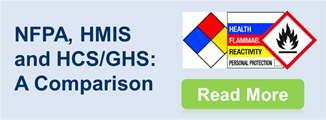GHS Precautionary Statement and P Code
Updated on 14 April 2015 by Mr Little Pro. [Disclaimer]
GHS precautionary statement means a standard phrase that describes measures to minimize or prevent adverse effects of a chemical assigned to a hazard class and category. Each precautionary statement is designated a code, starting with the letter P and followed by 3 digits.
- P1xx: general precautionary statement;
- P2xx: prevention precautionary statement;
- P3xx: response precautionary statement;
- P4xx: storage precautionary statement;
- P5xx: disposal precautionary statement; .
It shall be noted that the P code is used for reference purpose only. It is the actual phrase which should appear on labels and safety data sheets.
List of GHS Precautionary Statements and P Codes
P101: If medical advice is needed, have product container or label at hand.
P102: Keep out of reach of children.
P103: Read label before use.
P201: Obtain special instructions before use.
P202: Do not handle until all safety precautions have been read and understood.
P210: Keep away from heat/sparks/open flames/hot surfaces. - No smoking.
P211: Do not spray on an open flame or other ignition source.
P220: Keep/Store away from clothing/.../combustible materials.
P221: Take any precaution to avoid mixing with combustibles...
P222: Do not allow contact with air.
P223: Keep away from any possible contact with water, because of violent reaction and possible flash fire.
P230: Keep wetted with...
P231: Handle under inert gas.
P232: Protect from moisture.
P233: Keep container tightly closed.
P234: Keep only in original container.
P235: Keep cool.
P240: Ground/bond container and receiving equipment.
P241: Use explosion-proof electrical/ventilating/lighting/.../equipment.
P242: Use only non-sparking tools.
P243: Take precautionary measures against static discharge.
P244: Keep reduction valves free from grease and oil.
P250: Do not subject to grinding/shock/.../friction.
P251: Pressurized container: Do not pierce or burn, even after use.
P260: Do not breathe dust/fume/gas/mist/vapours/spray.
P261: Avoid breathing dust/fume/gas/mist/vapours/spray.
P262: Do not get in eyes, on skin, or on clothing.
P263: Avoid contact during pregnancy/while nursing.
P264: Wash бн thoroughly after handling.
P270: Do no eat, drink or smoke when using this product.
P271: Use only outdoors or in a well-ventilated area.
P272: Contaminated work clothing should not be allowed out of the workplace.
P273: Avoid release to the environment.
P280: Wear protective gloves/protective clothing/eye protection/face protection.
P281: Use personal protective equipment as required.
P282: Wear cold insulating gloves/face shield/eye protection.
P283: Wear fire/flame resistant/retardant clothing.
P284: Wear respiratory protection.
P285: In case of inadequate ventilation wear respiratory protection.
P231 + P232: Handle under inert gas. Protect from moisture.
P235 + P410: Keep cool. Protect from sunlight.
P301: IF SWALLOWED:
P302: IF ON SKIN:
P303: IF ON SKIN (or hair):
P304: IF INHALED:
P305: IF IN EYES:
P306: IF ON CLOTHING:
P307: IF exposed:
P308: IF exposed or concerned:
P309: IF exposed or if you feel unwell:
P310: Immediately call a POISON CENTER or doctor/physician.
P311: Call a POISON CENTER or doctor/physician.
P312: Call a POISON CENTER or doctor/physician if you feel unwell.
P313: Get medical advice/attention.
P314: Get medical advice/attention if you feel unwell.
P315: Get immediate medical advice/attention.
P320: Specific treatment is urgent (see ... on this label).
P321: Specific treatment (see ... on this label).
P322: Specific measures (see ... on this label).
P330: Rinse mouth.
P331: Do NOT induce vomiting.
P332: If skin irritation occurs:
P333: If skin irritation or rash occurs:
P334: Immerse in cool water/wrap in wet bandages.
P335: Brush off loose particles from skin.
P336: Thaw frosted parts with lukewarm water. Do no rub affected area.
P337: If eye irritation persists:
P338: Remove contact lenses, if present and easy to do. Continue rinsing.
P340: Remove victim to fresh air and keep at rest in a position comfortable for breathing.
P341: If breathing is difficult, remove victim to fresh air and keep at rest in a position comfortable for breathing.
P342: If experiencing respiratory symptoms:
P350: Gently wash with plenty of soap and water.
P351: Rinse cautiously with water for several minutes.
P352: Wash with plenty of soap and water.
P353: Rinse skin with water/shower.
P360: Rinse immediately contaminated clothing and skin with plenty of water before removing clothes.
P361: Remove/Take off immediately all contaminated clothing.
P362: Take off contaminated clothing and wash before reuse.
P363: Wash contaminated clothing before reuse.
P370: In case of fire:
P371: In case of major fire and large quantities:
P372: Explosion risk in case of fire.
P373: DO NOT fight fire when fire reaches explosives.
P374: Fight fire with normal precautions from a reasonable distance.
P375: Fight fire remotely due to the risk of explosion.
P376: Stop leak if safe to do so.
P377: Leaking gas fire: Do not extinguish, unless leak can be stopped safely.
P378: Use ... for extinction.
P380: Evacuate area.
P381: Eliminate all ignition sources if safe to do so.
P390: Absorb spillage to prevent material damage.
P391: Collect spillage.
P301 + P310: IF SWALLOWED: Immediately call a POISON CENTER or doctor/physician.
P301 + P312: IF SWALLOWED: Call a POISON CENTER or doctor/physician if you feel unwell.
P301 +P330 + P331: IF SWALLOWED: rinse mouth. Do NOT induce vomiting.
P302 + P334: IF ON SKIN: Immerse in cool water/wrap in wet bandages.
P302 + P350: IF ON SKIN: Gently wash with plenty of soap and water.
P302 + P352: IF ON SKIN: Wash with plenty of soap and water.
P303 + P361 + P353: IF ON SKIN (or hair): Remove/Take off immediately all contaminated clothing. Rinse skin with water/shower.
P304 + P340: IF INHALED: Remove victim to fresh air and keep at rest in a position comfortable for breathing.
P304 + P341: IF INHALED: If breathing is difficult, remove victim to fresh air and keep at rest in a position comfortable for breathing.
P305 + P351 + P338: IF IN EYES: Rinse cautiously with water for several minutes. Remove contact lenses, if present and easy to do. Continue rinsing.
P306 + P360: IF ON CLOTHING: rinse immediately contaminated clothing and skin with plenty of water before removing clothes.
P307 + P311: IF exposed: Call a POISON CENTER or doctor/physician.
P308 + P313: IF exposed or concerned: Get medical advice/attention.
P309 + P311: IF exposed or if you feel unwell: Call a POISON CENTER or doctor/physician.
P332 + P313: If skin irritation occurs: Get medical advice/attention.
P333 + P313: If skin irritation or rash occurs: Get medical advice/attention.
P335 + P334: Brush off loose particles from skin. Immerse in cool water/wrap in wet bandages.
P337 + P313: If eye irritation persists: Get medical advice/attention.
P342 + P311: If experiencing respiratory symptoms: Call a POISON CENTER or doctor/physician.
P370 + P376: In case of fire: Stop leak if safe to do so.
P370 + P378: In case of fire: Use ... for extinction.
P370 + P380: In case of fire: Evacuate area.
P370 + P380 + P375: In case of fire: Evacuate area. Fight fire remotely due to the risk of explosion.
P371 + P380 + P375: In case of major fire and large quantities: Evacuate area. Fight fire remotely due to the risk of explosion.
P401: Store ...
P402: Store in a dry place.
P403: Store in a well-ventilated place.
P404: Store in a closed container.
P405: Store locked up.
P406: Store in corrosive resistant/... container with a resistant inner liner.
P407: Maintain air gap between stacks/pallets.
P410: Protect from sunlight.
P411: Store at temperatures not exceeding ... oC/...oF.
P412: Do not expose to temperatures exceeding 50 oC/122oF.
P413: Store bulk masses greater than ... kg/... lbs at temperatures not exceeding ... oC/...oF.
P420: Store away from other materials.
P422: Store contents under...
P402 + P404: Store in a dry place. Store in a closed container.
P403 + P233: Store in a well-ventilated place. Keep container tightly closed.
P403 + P235: Store in a well-ventilated place. Keep cool.
P410 + P403: Protect from sunlight. Store in a well-ventilated place.
P410 + P412: Protect from sunlight. Do no expose to temperatures exceeding 50 celcius degress.
P411 + P235: Store at temperatures not exceeding ...Keep cool.
P501: Dispose of contents/container to...
How to Find Precautionary Statements for A Chemical
You have to determine the hazard class and hazard category of a chemical first. Once the classification of a chemical has been determined, signal word, hazard pictograms, hazard statements and precautionary statements will be assigned (see example below for flammable liquids).





